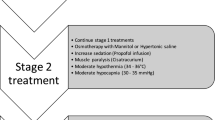Abstract
Severe head injury remains a major problem despite advances in recent years. The mortality of patients with a coma score of eight or less is still between 45–55% (Miller et al. 1981). In an attempt to improve outcome in a significant number of these patients, we have directed our efforts toward therapeutically influencing the brain and its environment after a severe head injury. Severe mechanical brain injury initiates a series of complex events in the brain which are thought to secondarily influence the ultimate outcome of the patient. One of these proposed secondary events is cerebral acidosis. The presence of cerebral acidosis has been inferred by the presence of lactate in ·the CSF of patients sustaining a severe mechanical brain injury (Cold et al. 1975, Enevoldsen et al. 1977, Sood et al. 1980). In addition, prognostic significance has been attached to high levels of lactate in the CSF after a severe brain injury (Crockard et al. 1972; Seitz and Ocker 1977). Furthermore, it has been shown that acidosis itself, when present as the result of any pathologic process, is harmful to the brain (Pulsinelli and Petito 1983). It was felt therefore that outcome from severe head injury might be improved if cerebral acidosis present after a head injury was treated.
Access this chapter
Tax calculation will be finalised at checkout
Purchases are for personal use only
Preview
Unable to display preview. Download preview PDF.
Similar content being viewed by others
References
Akioka T, Ota K, Matsumoto A, et al. (1976) The effect of THAM on acute intracranial hypertension. An experimental and clinical study. In: Beks JWF, Bosch DA, Brock M (eds): Intracranial pressure III. Springer, Berlin Heidelberg New York, pp 219–233
Cold G, Enevoldsen E, Malmros R (1975) Ventricular fluid lactate, pyruvate, bicarbonate, and pH in unconscious brain-injured patients subjected to controlled ventilation. Acta Neurol Scand 52: 187–195
Crockard HA, Taylor AR (1972) Serial CSF lactate-pyruvate values as a guide with acute severe head injury coma. Europ Neurol 8: 151–157
Enevoldsen EM, Jensen FT (1977) Cerebrospinal fluid lactate and pH in patients with acute severe head injury. Neurol Neurosurg 80: 213–225
Gaab M, Knoblich OE, Spohr A, Bourke H, Fuhrmeister U (1980) Effect of THAM on ICP, EEG, and tissue edema parameters in experimental and clinical brain edema. In: Shulman K, Marmarou A, Miller JD, Becker DP, Hochwald GM, Brock M (eds) Intracranial pressure IV. Springer, Berlin Heidelberg New York, pp 664–709
Gordon E, Rossanda M (1970) Further studies in cerebrospinal fluid acid-base status in patients with brain lesions. Acta Anaesthesiol Scand 14: 79–109
Miller JD, Butterworth JF, Gudeman SK, et al. (1981) Further experience in the management of severe head injury. Neurosurgery 54: 289–299
Pulsinelli WA, Petito CK (1981) The neurotoxicity of hydrogen ion. Stroke 14: 13
Rosner MJ, Becker DP (1984) Experimental brain injury: Successful therapy with a weak base tromethamine with an overview of CNS acidosis. J Neurosurg 60: 961–971
Rossanda M, Selenati, Villa L, et al. (1973) Role of automatic ventilation in treatment of severe head injuries. J Neurosurg Sci 17: 265–270
Seitz HD, Ocker H (1977) The prognostic and therapeutic importance of changes in the CSF during the acute stage of brain injury. Acta Neurologica 38: 211–231
Sood SC, Gulati SC, Kumar M, Kak VK (1980) Cerebral metabolism following brain injury. II. Lactic acid changes. Acta Neurochir (Wien) 53: 47–51
Author information
Authors and Affiliations
Editor information
Editors and Affiliations
Rights and permissions
Copyright information
© 1989 Springer-Verlag Berlin Heidelberg
About this paper
Cite this paper
Ward, J.D. et al. (1989). Effect of Prophylactic Hyperventilation on Outcome in Patients with Severe Head Injury. In: Hoff, J.T., Betz, A.L. (eds) Intracranial Pressure VII. Springer, Berlin, Heidelberg. https://doi.org/10.1007/978-3-642-73987-3_163
Download citation
DOI: https://doi.org/10.1007/978-3-642-73987-3_163
Publisher Name: Springer, Berlin, Heidelberg
Print ISBN: 978-3-642-73989-7
Online ISBN: 978-3-642-73987-3
eBook Packages: Springer Book Archive




